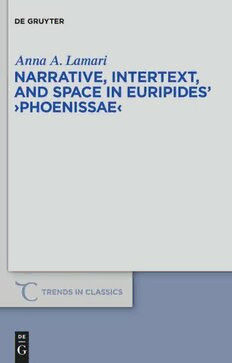
Narrative, Intertext, and Space in Euripides' "Phoenissae" PDF
262 Pages·2010·0.999 MB·English
Most books are stored in the elastic cloud where traffic is expensive. For this reason, we have a limit on daily download.
Preview Narrative, Intertext, and Space in Euripides' "Phoenissae"
Description:
Euripides’ Phoenissae bears one of the richest tragic plots: multiple narrative levels are interwoven by means of various anachronies, focalizers offer different and often challenging points of view, while a complex mythical matrix is deftly employed as the backdrop against which the exploration of the mechanics of tragic narrative takes place. After providing a critical perspective on the ongoing scholarly dialogue regarding narratology and drama, this book uses the former as a working tool for the study and interpretation of the latter. The Phoenissae is approached as a coherent narrative unit and issues like the use of myth, narrators, intertext, time and space are discussed in detail. It is within these contexts that the play is seen as a Theban mythical ‛thesaurus’ both exploring previous mythical ramifications and making new additions. The result is rewarding: Euripides constructs a handbook of the Theban saga that was informative for those mythically untrained, fascinating for those theatrically demanding, but also dexterously open upon each one’s reception.
See more
The list of books you might like
Most books are stored in the elastic cloud where traffic is expensive. For this reason, we have a limit on daily download.
